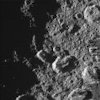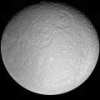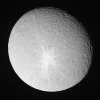Rhea is the second largest of Saturn's moons with an average diameter of 1,530 km. It orbits Saturn in a near circular orbit with a radius of 527,108 km (327,530 miles). It completes one orbit in just over 4.5 days. It comprises a surface of water ice, representing about 75% of the moon's volume, over a silicate core.
There are two very large craters Tirawa, about 360 km (~220 miles) across, and Mamaldi, which is somewhat larger but more degraded. Tirawa, the more recent crater, overlaps Mamaldi.
In 2008, NASA announced the discovery, by the Cassini probe, of a possible ring system around Rhea, comprising three narrow and extremely tenuous rings. Further observations by Cassini have failed to verity the initial observation.
There are two very large craters Tirawa, about 360 km (~220 miles) across, and Mamaldi, which is somewhat larger but more degraded. Tirawa, the more recent crater, overlaps Mamaldi.
In 2008, NASA announced the discovery, by the Cassini probe, of a possible ring system around Rhea, comprising three narrow and extremely tenuous rings. Further observations by Cassini have failed to verity the initial observation.
Rhea
Solar System -
Saturn's Moons
A new, unprocessed image of Rhea taken by Cassini on October 17, 2010 from a distance of approximately 39,610 km (c. 24,600 miles).
Credit: NASA/JPL/Space Science Institute
Cassini image showing the two largest impact craters. Mamaldi is a little indistinct but is just above and to the left of center. Slightly more visible, Tirawa is above and to the right of Mamaldi.
In this view of Rhea's leading hemisphere, you can see the Tirawa crater at the upper left, with crater Inktomi and its prominent ray system just below center.
Saturn's moons are grouped as follows. Select to see details of the moon or the group of moons:
Mimas • Enceladus • Tethys • Dione • Rhea • Titan • Iapetus • Hyperion • Norse Grp • Shepherd Moons • Alkyonides • Inuit Grp • Gallic Grp • Misc




